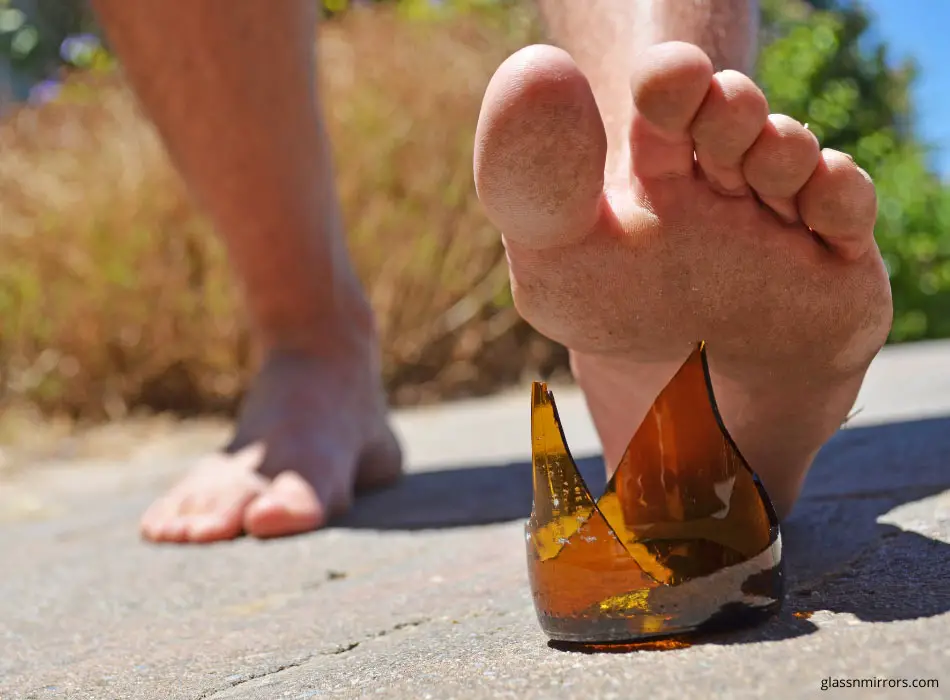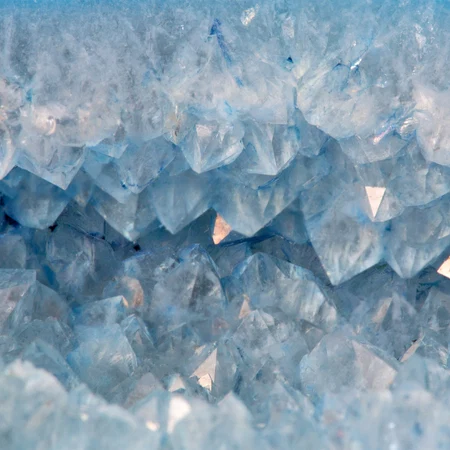As I spent many years installing glass and working with it, I often come across glass splinters in my hands. I often wondered if I ever got all of them out. I had plenty of training in what to do, but I still begged the question, can a piece of glass travel through your body?
A piece of glass can travel through the body if it enters the digestive system or a blood vessel. Since there is no way to place the shard inside a major vessel without puncturing the vessel, the blood pressure required to push is never built up, making such an occurrence impractical.
However, it is theoretically possible for tiny shards to travel far within the human body. In this article, I will explore what can happen if you step on glass or a splinter is lodged into your skin. You’ll discover the steps to remove a splinter from the skin and the origins of the traveling glass myth.
Table of Contents
- 1 What Happens If Glass Enters Your Bloodstream?
- 2 What Happens If You Get A Glass Splinter?
- 3 Can You Die From A Glass Splinter?
- 4 Can Your Body Break Down Glass?
- 5 What To Do If You Step On Glass
- 6 Do You Need Surgery To Remove Glass?
- 7 Areas To Protect From Glass
- 8 Traveling Splinter Myth Origin
- 9 How Deep Can A Splinter Go Safely?
- 10 Final Thoughts – Can Glass Go Through Your Body?
- 11 Hot Glass vs Cold Glass – What’s The Difference?
- 12 Can Quartz Be Made Into Glass? Guide On Quartz & Glass
- 13 What Is Panda Glass | Ultimate Guide To Panda Glass
What Happens If Glass Enters Your Bloodstream?

If glass enters your bloodstream, it can scar the inside of your blood vessels and cause internal bleeding. The chances of this actually happening are quite low because the skin prevents splinters from getting far enough inside the body to do such damage.
The chances are you will have a problem with bacteria before you ever have to worry about the glass.
What Happens If You Get A Glass Splinter?
If you get a glass splinter, you can feel discomfort and pain, but in most cases, the splinter comes out on its own or can be pulled out. If the glass splinter cannot be removed by yourself, you should immediately go to a hospital to have it removed.
Glass splinters often come out on their own because skin cells do not part to allow the splinter to travel into the bloodstream. The splinter is usually lodged into the skin’s upper layer, and as the body sheds skin cells, the splinter is removed.
If you’ve been poked by a glass shard and a pimple has formed around the area, your body is trying to get rid of the splinter by creating a blockage around it. If there’s no noticeable change, but the glass bit seems within reach, you might need to get it out yourself unless the splinter doesn’t hurt. In that case, you can leave it alone, and it will eventually find its way out.

Can You Die From A Glass Splinter?
It is theoretically possible to die from a glass splinter, but the evidence of this actually happening hasn’t surfaced. In most cases, a glass splinter doesn’t enter the body beyond the skin.
Since glass isn’t poisonous, having it lodged in one’s skin isn’t a health risk. However, splinters must be removed as soon as possible because they can cause pain.
To die from a glass splinter, the bit would have to reach the bloodstream. Even then, it would need to be small enough to be carried by the blood vessels. Given that feet, the most common body part to come in contact with splinters, don’t have major arteries and veins, it is safe to say that in most cases, no one dies from being poked by a glass splinter.
Can Your Body Break Down Glass?
Of course, that’s not to say that glass splinters should be taken lightly. Glass, whether ingested or lodged into the body, doesn’t get broken down. Consequently, it can cause internal scars and rupture minor vessels.
For this, the glass shard should go beyond the skin, which is quite rare. If someone is a victim of glassing (attack with a broken glass bottle or shank) or has stepped onto a long shard, fine bits can splinter inside the body. By then, blood loss becomes a greater problem than the body’s inability to break glass down.
You should be more worried about blood loss & infection,
rather than glass shards getting into the bloodstream!
If a glass splinter gets into your body, it will result in one of the two situations: the bit will be in your digestive system and will get removed with excrement, though it will cause scars along your digestive tract, or it will enter your blood vessel and keep circulating until removed with medical assistance.
If you have stepped on glass or gotten your skin punctured by a shard, the damage is likely surface-level.
To ensure that the glass splinter hasn’t gone beyond the lower layer of your skin, check for symptoms of glass splinter in your skin.
- A small line under the skin – This line is barely noticeable, but you should check for it in the area you suspect was punctured.
- You feel the splinter – It might feel like something is stuck underneath your skin and is pushing upwards. This is your body pushing the splinter out.
- Pain and redness – If you feel pain around the punctured area for days, there’s probably a splinter that’s a little tough for the body to push out. You’ll need tweezers for this one.
What To Do If You Step On Glass

Most symptoms of a splinter stuck in the skin require time, which is not something you have if you’ve stepped over glass. As mentioned earlier, if the glass punctures the skin and goes below the lower layer, tinier portions of the glass might break off inside the body. Alongside that, there’s potential for blood loss.
Here’s what you should do to avoid medical complications if you step on glass.
- Judge the puncture depth – If you’ve stepped onto the glass and the shard has obviously punctured at depth, removing the glass can cause blood loss and death. Seeking emergency support is advisable in such cases.
- Get a sanitizer and tweezers – If the glass hasn’t penetrated at depth, you’ll need to remove it at home. And the worst way to do that is to use your hands to yank it out.
- Sanitize the affected area – This is a crucial step in ensuring that the glass removal doesn’t allow germs to enter the body.
- Use tweezers to pull out the glass – Use your hands only when you don’t have tweezers. In that case, sanitizing your hands is crucial.
- Wash the area with soap – Once the glass is removed, you need to wash the affected area to make sure it is clean.
- Plug with cotton and a bandage – Finally, you can speed up the healing process by plugging the affected area with cotton and applying a bandage over it. This facilitates scab or clot healing.
- It is recommended to seek medical attention after this as you may require stitches.
If you don’t take out a glass splinter, the consequences can range from nil to life-threatening, and it depends entirely on how deeply the glass has punctured your skin. If the glass is lodged less than 1 millimeter into your skin’s upper layer, nothing will happen if you don’t take it out. You might feel uncomfortable or even experience pain, but there is no serious medical risk.
Getting the splinter out is still advisable. You just don’t need to rush to take it out. If the glass penetrates beyond 2 millimeters, you need to get it out as soon as possible. Again, if you expect blood loss, you should have a first aid provider remove it, and if you believe it can be managed at home, you can follow the steps listed earlier.
In case you do nothing, the glass splinter has a higher chance of breaking off inside your body. A nearly microscopic fracture within the splinter can lead to yet another splinter that might enter your bloodstream. A splinter in the bloodstream can theoretically reach the heart or at least cause major damage within the smaller blood vessels.
Do You Need Surgery To Remove Glass?
There have been instances where surgical procedures where shard residue was left in the body after major glass puncture injuries. Among these, the best-documented case is that of a 53-year-old patient who fell face-first into the shattered glass.
This drinking injury led to multiple shards puncturing the subject’s face. Since face skin has different depth and resistance compared to feet, this accident dealt more damage than stepping on glass. While most of the glass was removed using standard glass removal procedures, the patient found out about the remaining splinters two days after the accident. By then, the surgery was necessary. Even in that case, the splinters hadn’t reached the bloodstream.
It is definitely possible to experience a glass injury that makes surgery mandatory, but one must not assume that of any standard glass-related injury. Having a doctor see the affected area is the best way to know if the glass splinter has done enough damage to require surgery. And in most cases, it hasn’t.
Areas To Protect From Glass
The only time you need to be seriously concerned about a glass shard injury is when the affected area is close to major veins and arteries. When a splinter punctures such a spot, you risk losing blood. More importantly, a tiny portion of the splinter can further splinter and break off inside the bloodstream.
Here are the areas you need to protect from glass-related injuries.
- Inside of your legs – Protect your inner leg area, especially around the bones, as this is where one of the widest blood vessels is located quite close to the skin.
- Your back, near the kidneys – If you fall on your back over glass, the injury can be deadly. There’s a network of major vessels around this area.
- The wrists – Protecting the wrists is crucial not just because blood vessels are quite close to the skin in this area. It is important because wrists are the most at risk of glass injury right after feet. Of the two, your hands provide better access to blood vessels than the sole of your feet.
Traveling Splinter Myth Origin
It is critical to remember that even in the case of glass penetrating major veins and arteries, the actual risk is that of blood loss. The traveling glass splinter is, for now, a myth. There are no known cases of a glass shard traveling through the bloodstream and stabbing the heart resulting in the demise of the victim.
This isn’t an entirely made-up myth either. It has some basis in the truth. The traveling blood clot is a reality. On long flights and commutes, blood clots can form in the joints of people with blood thickness and blood pressure issues. When they stand up, the clot is pushed by liquid blood all the way to the heart, where it can cause a blockage leading to cardiac arrest.
But blood is inside the vessels already. For a glass splinter to have the same effect, it would need to be placed inside an artery or vein, and the specific vessel would need to be unscathed. Only then would there be significant blood pressure to push the shard all the way to the heart.
How Deep Can A Splinter Go Safely?
The skin is around 2 millimeters in depth, within which a splinter isn’t dangerous. A glass splinter needs to not just go beyond 2 millimeters but must be twice as far in for the back end of the splinter to be free from the skin’s hold.
If a splinter goes 4 millimeters inside the body, it can break off and be impossible to recover with a surface-level operation.
Another way glass can be nearly irrecoverable is if it is ground up and ingested. A myth around ground-up glass being used as a secret weapon has persisted since ancient times. However, science has debunked this based on the fact that powdered glass can be easily detected, and even though it can hurt one’s gut, it doesn’t kill the subject in the process of getting out.
Final Thoughts – Can Glass Go Through Your Body?
Glass can go through the body under such rare circumstances that the theory is, for the most part, a myth. The higher risk is severe blood loss and infection rather than the actual glass traveling through your body.
Most splinters are removed by a combination of skin resistance and human interference. The actual risk of glass accidents is not in the splinters entering the bloodstream. It is in glass puncturing the stream and resulting in blood loss.
-
Hot Glass vs Cold Glass – What’s The Difference?

When most people think of glass, they probably think of windows or drinking glasses. But there is a lot more to glass than that. In fact, there are two main … Keep Reading
-
Can Quartz Be Made Into Glass? Guide On Quartz & Glass

Glass making is a process that involves heating and cooling sand and other minerals. You may wonder whether it is possible to make glass out of quartz. Glass is made … Keep Reading
-
What Is Panda Glass | Ultimate Guide To Panda Glass

When looking for a new phone case, you may have encountered the term “panda glass.” A variety of phone cases on the market use this type of glass. But what … Keep Reading

2 thoughts on “Glass Can Go Through Your Body – Fact Or Fiction?”
Comments are closed.